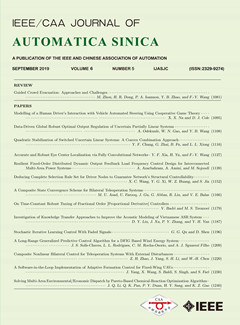 Volume 6
Issue 5
Volume 6
Issue 5
IEEE/CAA Journal of Automatica Sinica
| Citation: | Zhenhua Zhao, Jun Yang, Shihua Li and Wen-Hua Chen, "Composite Nonlinear Bilateral Control for Teleoperation Systems With External Disturbances," IEEE/CAA J. Autom. Sinica, vol. 6, no. 5, pp. 1220-1229, Sept. 2019. doi: 10.1109/JAS.2018.7511273 |

| [1] |
P. F. Hokayem and M. W. Spong, "Bilateral teleoperation: an historical survey, " Automatica, vol. 48, no. 12, pp. 2035-2057, 2006. http://d.old.wanfangdata.com.cn/NSTLQK/NSTL_QKJJ026987994/
|
| [2] |
J. Yan, X. Yang, C. Chen, and X. Guan, "Bilateral teleoperation of multiple agents with formation control, " IEEE/CAA J. Autom. Sinica, vol. 1, no. 2, pp. 141-148, Apr. 2014.
|
| [3] |
P. Xiong, X. Zhu, A. Song, L. Hu, X. Liu, and L. Feng, "A target grabbing strategy for telerobot based on improved stiffness display device, " IEEE/CAA J. Autom. Sinica, vol. 4, no. 4, pp. 661-667, Oct. 2017.
|
| [4] |
Z. Li, X. Cao, and N. Ding, "Adaptive fuzzy control for synchronization of nonlinear teleoperators with stochastic time-varying communication delays" IEEE Trans. Fuzzy Syst., vol. 19, no. 4, pp. 745-757, Aug. 2011.
|
| [5] |
Z. Li, Y. Xia, D. Wang, D. H. Zhai, C. Y. Sun, and X. Zhao, "Neural network-based control of networked trilateral teleoperation with geometrically unknown constraints, " IEEE Trans. Cybern., vol. 46, no. 5, pp. 1051-1064, May 2016.
|
| [6] |
D. A. Lawrence, "Stability and transparency in bilateral teleoperation, " IEEE Trans. Robot. Autom., vol. 9, no. 5, pp. 624-637, Oct. 1993.
|
| [7] |
N. Hogan "Impedance control: an approach to manipulation: Part Ⅱ-Implementation, " J. Dyn. Syst. Meas. Control Trans. ASME, vol. 107, pp. 8-16, Mar. 1985.
|
| [8] |
L. J. Love and W. J. Book, "Force reflecting teleoperation with adaptive impedance control, " IEEE Trans. Syst., Man, Cybern. B, Cybern., vol. 34, no. 1, pp. 159-165, Feb. 2004.
|
| [9] |
J. Yang, S. Li, and X. Yu, "Sliding-mode control for systems with mismatched uncertainties via a disturbance observer, " IEEE Trans. Ind. Electron., vol. 60, no. 1, pp. 160-169, Jan. 2013.
|
| [10] |
S. Sakaino, T. Sato, and K. Ohnishi, "Multi-DOF micro-macro bilateral controller using oblique coordinate control, " IEEE Trans. Ind. Informat., vol. 7, no. 3, pp. 446-454, Aug. 2011.
|
| [11] |
T. Nozaki, T. Mizoguchi, and K. Ohnishi, "Decoupling strategy for position and force control based on modal space disturbance observer, " IEEE Trans. Ind. Electron., vol. 61, no. 2, pp. 1022-1032, Feb. 2014.
|
| [12] |
K. Ohnishi, M. Shibata, and T. Murakami, "Motion control for advanced mechatronics, " IEEE/ASME Trans. Mechatronics, vol. 1, no. 1, pp. 56- 67, Mar. 1996.
|
| [13] |
W. H. Chen, D. J. Ballance, P. J. Gawthrop, and J. O'Reilly, "A nonlinear disturbance observer for robotic manipulators, " IEEE Trans. Ind. Electron., vol. 47, no. 4, pp. 932-938, Aug. 2000.
|
| [14] |
A. Hace and M. Franc, "Pseudo-sensorless high-performance bilateral teleoperation by sliding-mode control and FPGA, " IEEE/ASME Trans. Mechatron., vol. 19, no. 1, pp. 384-393, Feb. 2014.
|
| [15] |
X. Liu, R. Tao, and M. Tavakoli, "Adaptive control of uncertain nonlinear teleoperation systems, " Mechatronics, vol. 24, no. 1, pp. 66-78, 2014. Feb. 2014.
|
| [16] |
W. H. Chen, J. Yang, L. Guo, and S. Li, "Disturbance-observer-based control and related methods-An overview, " IEEE Trans. Ind. Electron., vol. 63, no. 2, pp. 1083-1095, Feb. 2016.
|
| [17] |
W. He, S. Zhang, and S. S. Ge, "Boundary output-feedback stabilization of a Timoshenko beam using disturbance observer, " IEEE Trans. Ind. Electron., vol. 60, no. 11, pp. 5186-5194, Nov. 2013.
|
| [18] |
W. He and S. S. Ge, "Vibration control of a nonuniform wind turbine tower via disturbance observer, " IEEE/ASME Trans. Mechatron., vol. 20, no. 1, pp. 237-244, Feb. 2015.
|
| [19] |
W. He, Z. Yan, C. Sun, and Y. Chen, "Adaptive neural network control of a flapping wing micro aerial vehicle with disturbance observer, " IEEE Trans. Cybern., vol. 47, no. 10, pp. 3452-3465, Oct. 2017.
|
| [20] |
M. Chen, P. Chen, and C. C. Lim, "Adaptive neural fault-tolerant control of a 3-DOF model helicopter system, " IEEE Trans. Syst. Man Cybern.-Syst., vol. 46, no. 2, pp. 260-270, Feb. 2016.
|
| [21] |
C. Mitsantisuk, S. Katsura, and K. Ohishi, "Force control of human-robot interaction using twin direct-drive motor system based on modal space design, " IEEE Trans. Ind. Electron., vol. 57, no. 4, pp. 1383- 1392, Aug. 2010.
|
| [22] |
S. Li, J. Yang, W. H. Chen, and X. Chen, "Generalized extended state observer based control for systems with mismatched uncertainties, " IEEE Trans. Ind. Electron., vol. 59, no. 12, pp. 4792-4802, Dec. 2012.
|